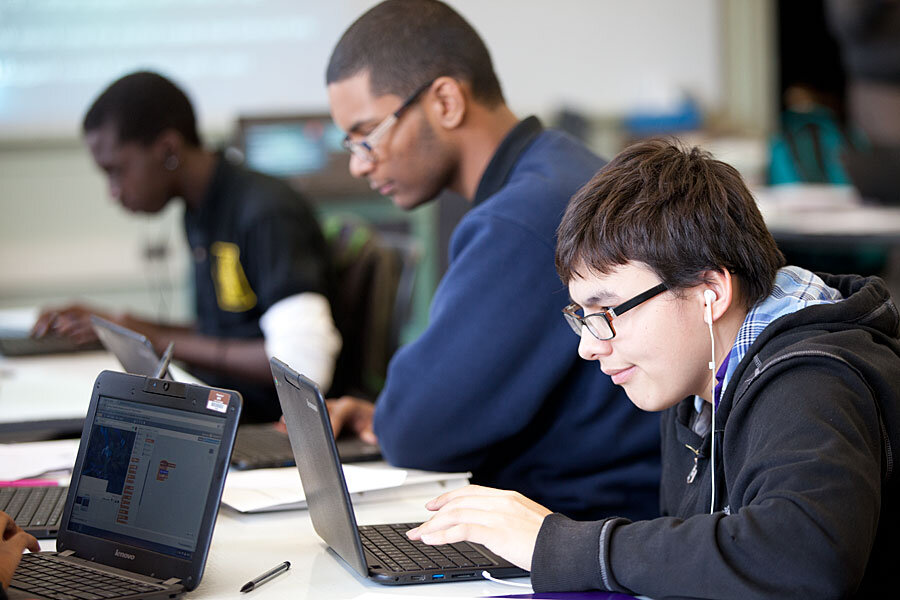How special needs students can benefit from STEM education
Loading...
For most of his academic career, Cullen excelled in math and computer science but struggled socially – that is, until he enrolled in a new Los Angeles private school that’s part of a nonprofit network.
"It's been a big change," his mother, Terry Whiteside, told CNN Money. "Before he wouldn't talk much about his day. Now he comes home and has conversations with me about what he did at school."
And here’s the kicker: Cullen has been diagnosed with autism. His school, STEM3 Academy, focuses on serving students with special needs, including those diagnosed with autism spectrum disorder, ADHD, and learning disabilities. As STEM3 joins a growing number of public, charter, and private institutions that focus on science, technology, engineering, and math (STEM) fields, education researchers have found that such specialty schools have exceptional benefits for not only those with special needs but also minority and female students.
"Our emphasis is on learning versus teaching," Ellis Crasnow, STEM3 ’s director, told CNN’s Parija Kavilanz. "Our students learn by doing, experiencing, and constructing rather than just sitting in a classroom listening to a teacher."
While focusing on the STEM subjects, teachers at the academy manage classes using a “flipped” model – instead of lecturing or teaching during school hours, class time is used for students to finish homework assignments and projects. Meanwhile, they use after-school hours to study on their own, reviewing the next day’s lessons.
This model is designed to be more suitable for their students and to help them overcome difficulties in social situations.
"As far as we know, we're the nation's only STEM-curriculum school for students with these needs," Dr. Crasnow said. "Our goal is to help them realize their potential for achievement in school, in college, and later in a STEM-based career."
In a 2012 study published in the Journal of Autism and Developmental Disorders, scientists found that students diagnosed with autism had the highest STEM participation rates. By examining 11,000 students nationwide, they found that young adults diagnosed with an autism spectrum disorder chose STEM majors in college more often than their peers in the general population – 34 percent versus less than 23 percent.
"It may be that people with autism naturally think like scientists,” Simon Baron-Cohen, director of the Autism Research Center at the University of Cambridge, told Scientific American magazine. "They look for patterns, and, in science, you are always looking for patterns that you hope reflect a natural law."
But the study also found such students are much less likely than their peers to enroll in college at all. This conclusion brings to the forefront the need for parents and educators to encourage kids with special needs to pursue higher education and thus help boost overall STEM participation.
And at STEM3 , that’s exactly what’s happening. Cullen, for instance, has been the object of interest for several top colleges. And companies such as defense contractor Raytheon and aerospace company Northrop Grumman have contacted the school about working with students.
"The stats regarding the post-high-school success of students with special needs is very poor. Eighty percent to 90 percent of them are unemployed or underemployed," said Crasnow. "These are horrific numbers and our goal is to change them."
In 2010, the Council of Advisors on Science and Technology under the Obama Administration called for 1,000 new STEM-focused schools to open by 2020 – a reaction to the country's subpar rankings in math and science compared to other industrialized nations. So far, there have been mixed results as to whether they’re successful.
But one 2014 study found positive results in such programs, reports Education Week. The study, led by Matthew Wiswall, a professor of economics at Arizona State University, analyzed the performance of 70,000 students attending public STEM high schools in New York City. They were able to find that three groups of students – females, Hispanics, and blacks – who are traditionally underrepresented in STEM fields did better in STEM-based high schools than non-STEM high schools.
"While the literature might suggest that STEMs are characterized by a 'chilly environment,' where minorities and females can feel unwelcomed, our results suggest that, in contrast, these schools are doing something right for them," the authors wrote.








